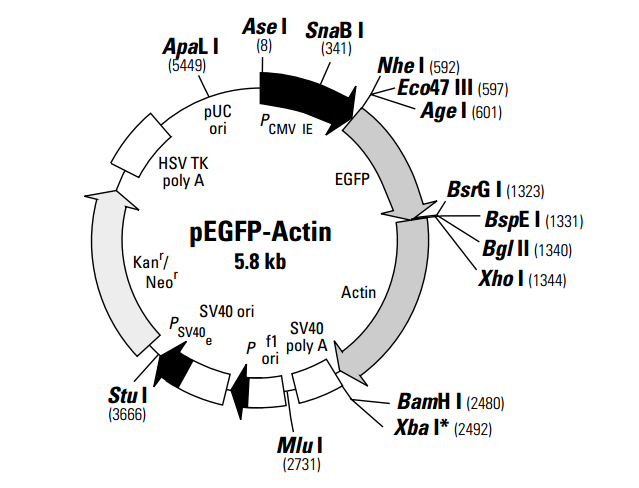
|
品牌 |
酶研生物 | |||||||||||||
货号 |
MY1128 | |||||||||||||
规格 |
2ug | |||||||||||||
价格 |
询价 | |||||||||||||
货期 |
现货 | |||||||||||||
pEGFP-Actin encodes a fusion protein consisting of the red-shifted, human codon-optimized variant of green fluorescent protein (EGFP; 1–3) and the gene encoding human cytoplasmic b-actin (4). EGFP, a derivative of the GFPmut1 variant (5), has been optimized for brighter fluorescence and higher expression in mammalian cells. (Excitation maximum = 488 nm; emission maximum = 507 nm.) This variant contains the double-amino-acid substitution of Phe-64 to Leu and Ser-65 to Thr, and also contains more than 190 silent base changes which correspond to human codon-usage preferences (6). SV40 polyadenylation signals downstream of the EGFP-Actin fusion direct proper processing of the 3' end of the EGFP mRNA. The vector backbone also contains an SV40 origin for replication in any mammalian cell line that expresses the SV40 T-antigen. A neomycin resistance cassette (Neor), consisting of the SV40 early promoter, the neomycin/kanamycin resistance gene of Tn5, and polyadenylation signals from the herpes simplex virus thymidine kinase (HSV-TK) gene, allows stably transfected eukaryotic cells to be selected using G418. A bacterial promoter upstream of this cassette drives expression of the gene encoding kanamycin resistance in E. coli. The pEGFPActin backbone also provides a pUC origin of replication for propagation in E. coli and an f1 origin for single-stranded DNA production. 载体应用The pEGFP-Actin Vector expresses the EGFP-Actin fusion protein in mammalian cells. The protein is incorporated into growing actin filaments and allows for visualization of actin-containing subcellular structures in living and fixed cells. (7, 8). pEGFP-Actin can be transfected into mammalian cells using any standard transfection method. If required, stable transformants can be selected using G418 (9).
|
|
|||||||||||||










